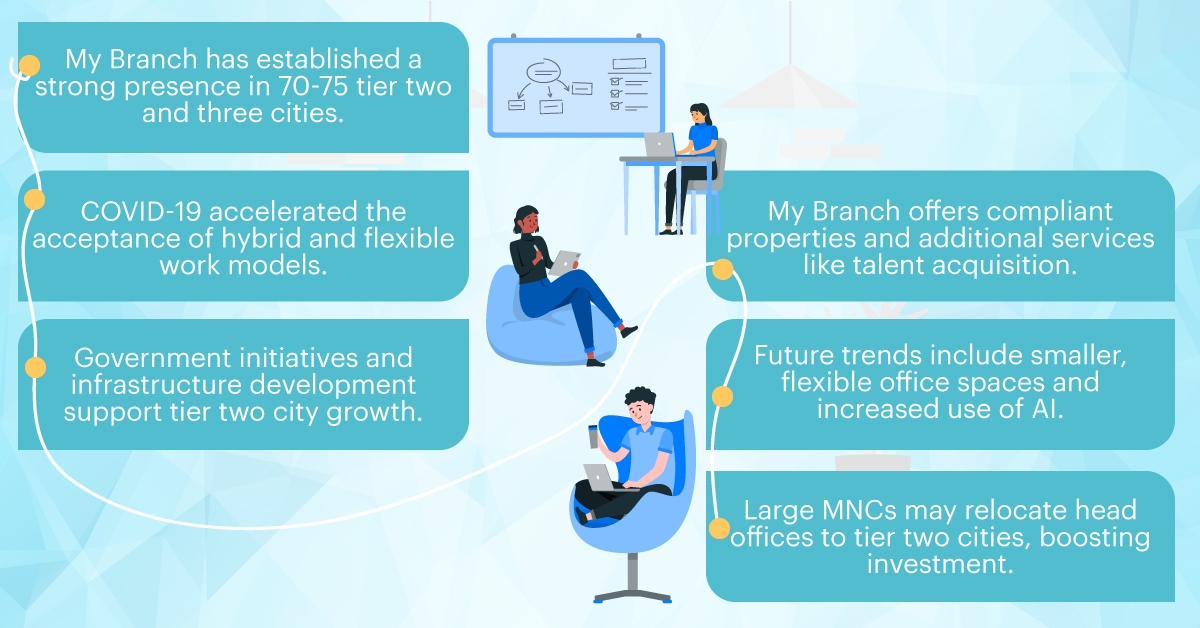Interviews
The Evolution of Coworking Spaces in India - A Deep Dive into My Branch's Journey
Shyam Nagarajan / Reading Time : 5 mins
Coworking has dramatically changed the trends of the commercial property market in India especially in the recent past. In a recent webinar, Kushal, founder of My Branch, focused on the analysis of realities at the level of tier two and three cities. The insights by Kushal were invaluable for defining the development, as well as future trials and triumphs of coworking spaces in India.
📑 Key chapter:
The Emergence of My Branch in Second and Third Tier Cities
My Branch has done so well to locate in 70-75 cities though most of them are in tier two and three cities. Kushal, a Chartered Accountant, ensured that he applied his specialty to tackle issues faced while operating businesses in these environments. The company was formed in the year 2016 and the first client was acquired at Jamshedpur. Today, customer retention and satisfaction rate at My Branch is high which is proof of a good service quality.
Kushal contributes this to the ability to capture the requirements of tier two markets and the provision of adequate solutions. Thus, becoming one of the leading players on the market offering flexible customer-oriented office spaces, My Branch has managed to become associated with characteristics like reliability and adaptability. This strategic positioning has helped the company to grow very fast and most of the expansion is usually occasioned by demand on the opportunities that are available.
In this process, COVID-19 played a huge role in the industry and also impacted the business. As Kushal mentioned, there has been a paradigm shift within organizations’ strategic approaches to embracing a work from home culture that has equally been propitious to the success of the coworking industry.
A worrying trend in coworking spaces
Read NowCoworking spaces have helped spur this transition especially since they offer business open spaces for use only when needed on a payable basis. The new forms of work organization – work from home and work from the office have appeared to be mutually beneficial for enterprises and service providers. Today, employees are rostered because they need to interact in a team on a particular day and this makes the best use of office space hence cutting costs.
Kushal provided examples of people that have adopted this model. For instance, a banking professional who works remotely from home but presents himself physically for important office days. It has not only enabled the staff to work smarter with better work-life balance but has also helped the companies to continue with their production and communication.
Watch the webinar here:
Government of India Efforts And Infrastructure Creation
The commitments have been largely made by the different tiers of the government besides the general improvement of the transport infrastructure which has boosted the growth of the tier two cities. Kushal also emphasised that the government has worked well towards employment generation, and accessibility enhancement through better roads and transport mediums. For example, urban centers such as Nagpur have introduced multiple tier transport networks, thus making them more accessible, and ideal for business undertakings.
The lower cost of living and lesser employee turnover adding up to the reason making tier two cities attractive. They are given the needed boost by government and infrastructure enhancements, thus holding the prospect of rapid organic growth and ideal for the growth of coworking space.
Strategies specific to My Branch
When asked about how My Branch is accustoming to changing landscapes and coworking industry needs, he said,
Achieving the right kind of properties and dealing with smaller office spaces are two important elements of their strategies. Many of the tier two spaces may not have buildings that are fully compliant, or large floor properties are not easily obtained. My Branch solves this problem through offering properties, which are already compliant with legal requirements, hence clients do not have to worry about inconveniences.
Also, it has value addition services like the recruitment of talented employees and record compliance. Such services improve the offering of services to the clients and make My Branch offer diverse services to the businesses taking new premises in the tier two cities. Hence, by using technology and AI solutions, the firm improves the use of space and organizational performance, giving it a competitive advantage in the market.
The Future of Coworking Spaces and the Trends on the Market
Below are the predicted key trend for the future of coworking establishment:
- Kushal forecasted that changes in size and office design would be prevalent due to hybrid working modes. Trends towards having specific meeting facilities and enormous individual offices are no longer important since the modern environment accentuates open and versatile design. The change is possible to optimize the use of space and security and, consequently, reduce the costs.
- New forms of business and generating revenues are developing, for example, Offices on Demand and Shared Office Days. Employers are now searching for more and more ‘soft’ solutions that will help them bring that unused real estate space to full advantage. For example, some models supply offices for certain days of the week, and that makes it possible for a number of enterprises to occupy the same working space.
- The coworking operators and developers are also likely to show a growing level of interaction. This situation is even more evident in tier two cities where many large developers are missing and vendors such as My Branch act as suppliers for the demand side of coworking spaces. Additional advancement in the construction of more infrastructures and governmental support will increase the growth potential of such markets.
- Another promising factor is that large MNCs can possibly set up their head offices in tier two cities for possible change. Prospects of these markets mean that they are capable of providing economic solutions to the traditional Tier One cities, and therefore boost investment.
The fundamental purpose of this report is to give a holistic view regarding the current and future state of coworking offices in India. The example of My Branch proves the high significance of the effect in the tier two and three markets. The current situation caused by COVID-19, actions of governments, and the transition to hybrid work environments have revealed new potential for development.

The future of the coworking space industry remains very promising. Companies like My Branch will be attaining its leadership. On the customer satisfaction, flexibility and utilization of technology, they set the pace for other companies to emulate. The prospects of coworking spaces seem quite optimistic in India as the Tier II cities seem to be contributing majorly in this revolution.

